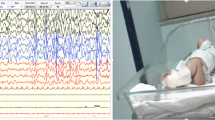Abstract
Objectives
To elucidate the electroclinical characteristics of infantile epileptic spasms syndrome (IESS) and to determine any potential association among these with underlying etiologies and response to therapy.
Methods
Sixty-eight, treatment-naive children with IESS underwent long-term video electroencephalogram (EEG) recording, which was used to characterize the semiology, ictal, and inter-ictal EEG patterns. Children were further followed up to assess electroclinical predictors of etiologies and short-term therapeutic response.
Results
Of 68 children enrolled (69% boys), the median age at enrollment was 10.5 mo (IQR-8). Eighty-eight percent of children had flexor spasms, followed by mixed (7%) and extensor (4.4%). Asymmetrical spasms were noted in 17.6% children, and all of them had underlying structural etiology. Two children had the status of epileptic spasms. In the present cohort, authors recognized five distinct ictal EEG correlates of epileptic spasms; the frontocentral dominant slow wave was the most prevalent (32%), followed by the generalized slow-wave complex with superimposed fast rhythm in 29.4%. The occipital dominant slow wave complex was a peculiar pattern in 16%. The major underlying etiologies were hypoxic-ischemic brain injuries (36.7%) and neonatal hypoglycemic brain injuries (22%). Besides asymmetric spasms, authors could not identify any significant association among electroclinical characteristics, underlying etiologies and response to therapy in this study.
Conclusions
The electroclinical landscape of IESS is peculiar and diverse in developing countries. The presence of asymmetrical spasms indicated underlying structural etiology.


Similar content being viewed by others
References
Zuberi SM, Wirrell E, Yozawitz E, et al. ILAE classification and definition of epilepsy syndromes with onset in neonates and infants: position statement by the ILAE Task Force on Nosology and Definitions. Epilepsia. 2022. https://doi.org/10.1111/epi.17239.
Pavone P, Polizzi A, Marino SD, et al. West syndrome: a comprehensive review. Neurol Sci. 2020;41:3547–62.
Sahu JK, Madaan P, Prakash K. The landscape of infantile epileptic spasms syndrome in South Asia: peculiarities, challenges, and way forward. Lancet Reg Health Southeast Asia. 2023;12:100170.
King DW, Dyken PR, Spinks IL, Murvin AJ. Infantile spasms: ictal phenomena. Pediatr Neurol. 1985;1:213–8.
Kellaway P, Hrachovy RA, Frost JD, Zion T. Precise characterization and quantification of infantile spasms. Ann Neurol. 1979;6:214–8.
Watanabe K, Negoro T, Okumura A. Symptomatology of infantile spasms. Brain Dev. 2001;23:453–66.
Jain P, Sahu JK, Horn PS, et al. Treatment of children with infantile spasms: a network meta-analysis. Dev Med Child Neurol. 2022;64:1330–43.
Devi N, Madaan P, Kandoth N, Bansal D, Sahu JK. Efficacy and safety of dietary therapies for childhood drug-resistant epilepsy: a systematic review and network meta-analysis. JAMA Pediatr. 2023;177:258–66.
Fusco L, Vigevano F. Ictal clinical electroencephalographic findings of spasms in West syndrome. Epilepsia. 1993;34:671–8.
Madaan P, Chand P, Linn K, et al. Management practices for West syndrome in South Asia: a survey study and meta-analysis. Epilepsia Open. 2020;5:461–74.
Bhanudeep S, Madaan P, Sankhyan N, et al. Long-term epilepsy control, motor function, cognition, sleep and quality of life in children with West syndrome. Epilepsy Res. 2021;173:106629.
Iype M, Kunju PAM, Saradakutty G, Mohan D, Khan SAM. The early electroclinical manifestations of infantile spasms: a video EEG study. Ann Indian Acad Neurol. 2016;19:52–7.
Caraballo R, Semprino M, Fasulo L, et al. Status of epileptic spasms: a study of 21 children. Epilepsy Behav. 2022;126:108451.
Mytinger JR, Hussain SA, Islam MP, et al. Improving the inter-rater agreement of hypsarrhythmia using a simplified EEG grading scale for children with infantile spasms. Epilepsy Res. 2015;116:93–8.
Haneder C, Stark B, Peherstorfer A, Gröppel G. Focal signs in infantile spasms. Seizure. 2022;96:95–7.
Pachatz C, Fusco L, Vigevano F. Epileptic spasms and partial seizures as a single ictal event. Epilepsia. 2003;44:693–700.
Maki Y, Natsume J, Ito Y, et al. Involvement of the thalamus, hippocampus, and brainstem in hypsarrhythmia of West syndrome: simultaneous recordings of electroencephalography and fMRI study. AJNR Am J Neuroradiol. 2022;43:1502–7.
Siniatchkin M, Coropceanu D, Moeller F, Boor R, Stephani U. EEG-fMRI reveals activation of brainstem and thalamus in patients with Lennox-Gastaut syndrome. Epilepsia. 2011;52:766–74.
Lee CH, Le JT, Ballester-Rosado CJ, Anderson AE, Swann JW. Neocortical slow oscillations implicated in the generation of epileptic spasms. Ann Neurol. 2021;89:226–41.
Eisermann M, Fillon L, Saitovitch A, et al. Periodic electroencephalographic discharges and epileptic spasms involve cortico-striatal-thalamic loops on arterial spin labeling magnetic resonance imaging. Brain Commun. 2022;4:fcac250.
Inoue T, Kobayashi K, Matsumoto R, et al. Engagement of cortico-cortical and cortico-subcortical networks in a patient with epileptic spasms: an integrated neurophysiological study. Clin Neurophysiol. 2020;131:2255–64.
Acknowledgements
SN (Grant reference No.3/1/3/147/Neuro/2021-NCD-1) was supported by the Indian Council of Medical Research (ICMR). JKS received grant from Indian Council of Medical Research paid to his Institute (Reference No F.N.7/1/3/2018-RMC). The authors also acknowledge Vinay Kumar, Isheeta Shyam, Baljit Singh and Seema Nain who performed video EEG recordings. They also acknowledge families of all children with infantile epileptic spasms syndrome who participated in the study.
Author information
Authors and Affiliations
Contributions
PP: study design, drafting the work, data collection, data analysis, data interpretation, manuscript writing and approval of the manuscript; SN, PM, CA: drafting the work, data collection, data analysis, data interpretation, manuscript writing and approval of the manuscript; JB, AGS, RS, NS: study design, drafting the work, data collection, data interpretation, manuscript writing and approval of the manuscript; JKS: conceptualization of study and design, drafting the work, data collection, data interpretation, manuscript writing and approval of the manuscript. JKS will act as guarantor for this manuscript.
Corresponding author
Ethics declarations
Conflict of Interest
None.
Additional information
Publisher’s Note
Springer Nature remains neutral with regard to jurisdictional claims in published maps and institutional affiliations.
Electronic Supplementary Material
Below is the link to the electronic supplementary material.
Rights and permissions
Springer Nature or its licensor (e.g. a society or other partner) holds exclusive rights to this article under a publishing agreement with the author(s) or other rightsholder(s); author self-archiving of the accepted manuscript version of this article is solely governed by the terms of such publishing agreement and applicable law.
About this article
Cite this article
Pal, P., Negi, S., Baishya, J. et al. Electroclinical Landscape of Infantile Epileptic Spasms Syndrome. Indian J Pediatr (2024). https://doi.org/10.1007/s12098-023-05017-6
Received:
Accepted:
Published:
DOI: https://doi.org/10.1007/s12098-023-05017-6




